Abstract
The urgency of the issue is due to the importance of studying teenage years. It is characterized by the development crisis, there is a new level of consciousness: the development of self-image, reflection emergence, realizing one’s own individuality, the will for autonomy. There are issues of pedagogical assistance to a younger generation, and especially to the part of it that, due to objective and subjective reasons, may be at risk. The most important task facing school is a solution to the problem of organizing effective prevention and correction of children’s negative behavioural characteristics. A significant aspect of the problem is that adolescence, age as a biopsychosocial phenomenon is a specific temporal structure of behaviour, which includes social competence, reflecting the degree of the subject’s situational awareness. The main field in studying the problem is the criteria for the revealed social competence, which characterize the engagement of a teenager into the field of deviant activities: affiliation, self-esteem, aggressiveness, anxiety. The main content of the study is behavioural criteria of adolescents. It allows obtaining reliable information both about features of adolescent behaviour, and trends in individual characteristics in self-esteem, anxiety, aggressiveness, and affiliation. In the study, the variations of the expressed criteria serve the basis for identifying the types of social competence development of children at risk. So the following types and characteristics of social competence of children included in the risk group can be differentiated: variative, compulsive, marginal. A criterion analysis of the types of social competence of adolescents is presented.
Keywords: Psychological factors, adolescent, types of social competence
Introduction
The problematic area of the educational system is the contradiction between the traditional heavy-handed, dissubjectified paradigm, within which a socializing function of a school is often carried out, and the ideas of anthropocentrism, morality, preservation and development of social values in humanistically oriented interaction. Together with new, advanced, progressive ideas in education, there are costs and transitional excesses, which makes serious demands on the quality of the educational system of the process and the results of social development of children and adolescents (Abramenko, 2015).
Nowadays, a child lives, socializes in an era of endless changes. He is more influenced by external factors and tends to perceive all phenomena of social reality much more vividly than other social groups since he is at the stage of socialization without the developed attitude to these realities (Deci & Ryan, 1986). It is necessary to solve the issues of pedagogical assistance to the younger generation, especially those who, due to external and internal reasons, may be at risk. The most important task facing school at present is to solve the problem of organizing effective prevention and correction of negative behavioural characteristics of children at risk (Schipanova, 2015). At this case, simplifications are completely unacceptable, since they explain only their powerlessness and eventually, arbitrary behaviour in the field of education at all its levels (Seviaryn et al., 2019)
As observed in the research of Reifschneider, Mizina, the peculiarity of social and educational work in the view of pedagogical support is its targeting. Some authors’ studies emphasize that the addressee of pedagogical assistance is most often a category of children whose behaviour contradicts common social regulations and rules, i.e. from the point of view of the risk of their actions concerning society: psychological support for adolescents with addictive behaviour. In Kulagina, Pokrass’s studies, growing-up years are defined as a biopsychosocial phenomenon, constitutes a specific temporal structure of behaviour.
Adolescence can be designated as a transformation stage. Overcoming it, a teenager becomes an adult (J. J. Rousseau). Defining adolescence as contradictory and conflicting, Hall characterizes it as a period of ‘storm-and-stress ‘, since the changes that take place in a teenager’s body are very intense and lead to instability, the inconsistency of the general state of the body. Freud defines the inconsistency of this age as global and comprehensive. Bochaver defines this phenomenon as the birth of a child’s subjectivity on the border with the world (Romanova et al., 2018). In his opinion, teenagers are enthusiastically involved in the community life, and at the same time they tend to privacy, simultaneously be dependent on the declared leader nod and resisting any power.
The behaviour of teenagers is often impudent and rude to others, although they are very vulnerable. To win their spurs, a teenager tries to achieve his goal in extraordinary ways (Abramenko et al., 2018). Adolescence as a biopsychosocial phenomenon has a specific temporal structure of behaviour, which is characterized by social competence, showing the degree of the subject’s situational awareness. Adolescence is a period of a child’s growing up, self-consciousness development and, as a result, the growing contradiction between his own needs and capabilities, allows the authors to outline the criteria for social competence presentation: self-esteem, anxiety, aggressiveness and affiliation. These criteria build up the classification of adolescents at risk by social competence type: marginal, variative, compulsive.
Problem Statement
Adolescence is characterized by the development crisis, where there is a new level of self-consciousness: the development of self-concept, e reflection emergence, the awareness of one’s individuality, the will of autonomy. Living in the world of adults and children, a teenager shows emotional instability and tension, modesty and aggressiveness, all-or-nothing mentality, risk-taking and self-testing, as a process of transformation and internal organization of the social norms of behaviour adoption that rule the society (Golovanova & Dermanova, 2018).
Adolescence is marked as еру development crisis when a new level of self-consciousness occurs: the discovery and manifestation of one’s self-image, the awareness of one’s individuality, the emergence of reflection, the will of autonomy (Kovalenko, 2017)
The adolescent exists in two cultures: in the world of adults and that of children. As a consequence, there is an expression of emotional instability and tension, modesty and aggressiveness, black-and-white thinking, risk-taking and self-testing (Parens, 1997); the genesis of moral consciousness as a process of transformation and internal organization of the relevant norms and rules (Abramenko, 2015).
This age is marked with such features as ‘difficult’, ‘critical’, ‘conflict’, ‘children at risk’. In this study, the at-risk group is reviewed according to a contingency perspective. The at-risk group is regarded by the authors, not as an established (registered) social group but a dynamic structure with mobile temporal and spatial parameters.
This is a specific situation, acting as a set of professionally defined socio-psychological criteria, circumstances, signs, behavioural characteristics that determine the situation called a person (child) is at a risk area (Parens, 1997).
Children of the risk group are the children whose socialization is disrupted under the influence of social environment because they do not develop an adequate socio-cultural adaptation mechanism as a result of the current shortcomings in physical and mental development; family problems of various kinds.
Research Questions
At-risk youth performance of higher social needs, in particular, the needs for social approval, affiliation, self-actualization, and others, are often difficult.
This is inherent in the group attribute of social risk. As a result, interpersonal relationships become conflicted, the structure of an adolescent’s self-image is distorted, which, in turn, gives rise to distrust towards the world. This is the way to delinquent and social maladjustment.
The risk factor is used to identify the features of a child’s neuropsychological development at the initial stages of ontogenesis. All this serves as some prerequisites for certain deviations in the subsequent child development. These include such factors as hyperexcitability and on the contrary, hypermotivity, terms in the development of psychomotor actions, namely their delays, communication problems, emotionalism, increased vulnerability, a block of mental processes (Horney, 2002).
The use of these features can make a teenager feel comfortable in an uncomfortable environment, and such a condition can become the same habit for him as one of clothing.
The risk factor is used to consider the living conditions, development and upbringing of a teenager that negatively affect the process of his development: low social and economic family status, emotional deprivation, difficult peer-to-peer communication, sometimes causing conflict situations, information overload at school, lack of reasonable requirements that exceed a child’s abilities, both at school and in the family (Abramenko et al., 2018).
The criteria for demonstrating social competence that characterize a teenager’s involvement in the domain of deviant activities include self-esteem, aggressiveness, and anxiety.
As many national and foreign scientists’ research make good their argument by showing the held signs of social competence in a teenager’s behaviour allows the experts to talk about the high probability of antisocial interaction strategies used by a teenager, in other words, to include him in the category of at-risk groups (R. Burns, S. Buhler, G. Selye).
The combination of these features is, in the authors’ point of view, the most appropriate, allowing classifying the risk group by the type of social competence: marginal, variative, compulsive, which can also be defined as an at-risk group.
Purpose of the Study
The purpose of the presented research is to analyze theoretically and empirically psychological factors resulted in a risk group in adolescence.
Research Methods
The sample of the study involves 60 teenagers of Secondary School No. 10, Gymnasium No. 1 (Birobidzhan City). The representativeness of the study sample is represented by the fact that the sample included teenagers of senior school since representatives of this age fall into the field of deviance activities most often.
The subject of the study is psychological factors resulted in an at-risk group.
For the experimental study, the authors use expert assessment of basic types of social competence (cards with characteristics of types of social competence). Teachers choose which type each child is more according to Eidemiller method for determining the manifestations of accentuations of personality traits in behaviour). Spielberger method is a tool that allows the authors to measure differentially anxiety as personal property and as a state.
Buss-Durkee Hostility Inventory determines the hostility level and final aggressiveness and assesses the aggressiveness level and its variations.
To study the self-esteem development level, the authors use a personal self-esteem scale ‘Who am I? ‘developed by Prigozhin, which studies the main characteristics of self-image and their demonstration.
Findings
The authors determine the factors that set the criteria for the development of social competence of children at risk: the quality of self-esteem, the anxiety level, aggressiveness. On this basis, the characteristics of the types of development of social competence of children at risk are given, depending on the degree of these criteria intensity: variative, compulsive, marginal.
According to the types of social competence, the children are distributed according to the teachers’ expert survey. Based on this survey, the students in the experimental and control groups are distributed according to the type of social competence (Figure 01).
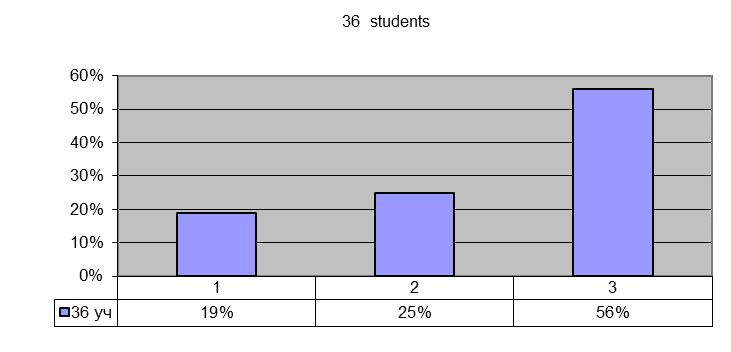
As a result of the experimental study, the following monographic characteristics of the social competence types are determined:
Describing teenagers of a marginal behavioural type, teachers note their mood swings, volcanic blow off of sympathy and vice versa, unfathomable hostility. So, all of the traits are illogical. Self-esteem is inadequate, but it can be an inflated or a low self-concept. Marginal adolescents have a predetermined outcome of behaviour based on dogmatism and are beyond any modification.
According to the research of foreign psychologists (D. Bell, E. Fromm, J. Domenech), sociologists emphasize agreeableness as an internal property of individual consciousness.
Conformists are dependent on group pressure very much. Adolescents of the conformal type of social competence show accessibility, compliance with the bandwagon effect. Adolescents of compulsive type of social competence have a high level of adherence to principles. Variative teenagers always listen to the opinion of appreciated adults and very communicative. The adolescents in focus study well, are active, sociable, bright personalities with a positive attitude.
Criteria-based analysis of social competence types of adolescents is shown (Table 01).
The review of results of the criteria study for the social competence of adolescents shows that, compared to other types of social competence, marginal ones are distinguished in aggression (22 points), hostility (12 points) and anxiety (47.3 points).
The self-esteem development level of adolescents of different types of social competence at the beginning of the experiment is presented (Figure 02).
Based on the self-assessment scale developed by Prigozhin, it should be noted that differences in self-evaluation of adolescents of different types of social competence are small. Marginal adolescents’ self-esteem is near to low (26 points), compulsive adolescents’ self-esteem is (22 points), variative adolescents’ self-esteem is adequate (21 points).
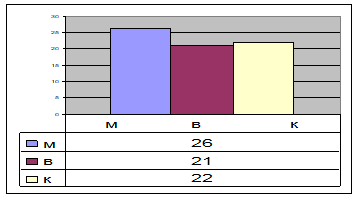
In the study on the aggressiveness test, the authors find out that the marginal index of aggressiveness is within the normal range (20-25 points), but is overestimated in comparison with other types. The aggressiveness of variative adolescents (17 points) is slightly higher than that of compulsive ones (15.1 points). Aggressiveness is resulting in increased irritability. The aggressiveness index of adolescents of different types of social competence (Figure 03).
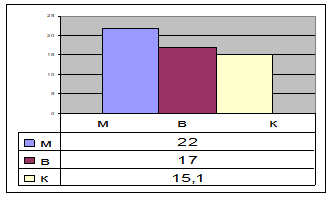
After studying the hostility level, it can be seen that marginal adolescents have the highest hostility index, which is above the norm (12 points). Compulsive ones also have an increased one (9 points), although it is within the normal range (1-10 points) (Figure 04).
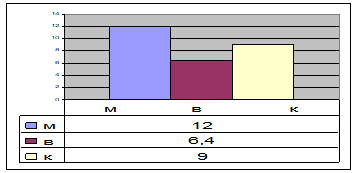
The study shows that adolescents with a marginal type of social competence have increased anxiety (47.3 points). Although it is within the normal range (50 points), it is overestimated in comparison with other types of social competence (Figure 05).
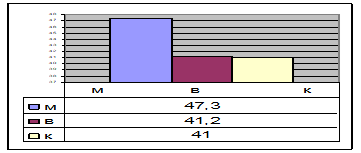
The tested adolescents with a high anxiety level have an inadequate attitude to themselves. They have low self-esteem, difficult relationships with peers. They are not going to be leaders, do not want to be good at studies, meeting new people causes anxiety.
Conclusion
Focusing on psychological risk factors and taking into account that even the most problem-free child can be in the risk zone, the teachers classify adolescents by different risk categories. The following types of social competence are differentiated: variative, compulsive, and marginal, which can be designated as a risk group.
Catching in a teenager behaviour such qualities as aggressiveness, anxiety, dissatisfaction in communication, inadequate self-esteem, suggest the experts a high probability of using antisocial interaction strategies by a teenager, in other words, to classify him as a troubled teenager.
References
Abramenko, N. Yu., Lutsenko, E. L., Bogachenko, N. G., Tyurina, Yu., & Kalaur, V. S. (2018). Conflict management in the organization. Astra Salvensis - review of history and culture, (Special Issue), 353-360.
Abramenko, N. Yu. (2015) Psihologo-pedagogicheskoe soprovozhdenie detej gruppy riska v uslovijah social'no-vospitatel'noj raboty shkoly [Psychological and pedagogical support for children at risk in the conditions of social and educational work of the school]. Sholom-Aleichem Priamursky State University. [in Russ.].
Deci, E. L., & Ryan, R. (1986). The dynamics of self-determination in personality and development. In R. Schwarzer (Ed.), Self-related cognitions in anxiety and motivation (pp. 171–194). Lawrence Erlbaum Associates.
Horney, K. (2002). Nevroticheskaja lichnost' nashego vremeni [Neurotic personality of our time]. Peter [in Russ.].
Golovanova, N. F., & Dermanova, I. B. (2018). Samorealizacija i udovletvorennost' zhizn'ju podrostka: psihologo-pedagogicheskij aspekt [Self-Fulfillment and satisfaction with the life of a teenager: psychological and pedagogical aspect]. Izvestija Saratovskogo universiteta. Series: Acmeology of education. Developmental psychology, 7/3(27), 278-283. [in Russ.].
Kovalenko, A. P. (2017). Teoreticheskiy analiz vozniknoveniya konfliktnogo povedeniya lichnosti v nravstvennom vospitanii v sovremennom mire: psikhologo-pedagogicheskiy aspekt. [Theoretical analysis of the emergence of conflict behavior of the Individual moral education in the modern world: psychological and pedagogical aspect]. In Collected research materials from the proceedings of Scientific and practical conference, 66-69. Omsk-Sterlitamak: AMI. [in Russ.].
Parens, H. (1997). Agressiya Detey [Aggression of our children]. PH ‘Forum’: INFRA-M.
Romanova, E. S., Abushkin, B. M., Ovcharenko, L. Yu., Shilova, T. A., & Akhtyan, A. G. (2018). Factors of socialization of schoolchildren: psychological aspect. Astra Salvensis - review of history and culture, (Special Issue), 299-309.
Schipanova, D. E. (2015). Suverenitet psihologicheskogo prostranstva i ego svjaz' s disgarmoniej mezhlichnostnyh otnoshenij v podrostkovom vozraste [The sovereignty of psychological space and its relationship with the disharmony of interpersonal relations in adolescence]. In Collected research materials from the proceedings of International Interdisciplinary Research and Practice Conference «Psychology and Psychological Practices in Modern World», 267–276. Ural. [in Russ.].
Seviaryn, S. N., Saidzi, A. Ev., & Kukushkina, A. G. (2019). Post-Non-Classical Pedagogical Research Strategies. European Proceedings of Social and Behavioural Sciences. LXXXVII-PEHPP, 9-15.
Copyright information

This work is licensed under a Creative Commons Attribution-NonCommercial-NoDerivatives 4.0 International License.
About this article
Publication Date
21 June 2021
Article Doi
eBook ISBN
978-1-80296-110-2
Publisher
European Publisher
Volume
111
Print ISBN (optional)
-
Edition Number
1st Edition
Pages
1-1168
Subjects
Social sciences, education and psychology, technology and education, economics and law, interdisciplinary sciences
Cite this article as:
Abramenko, N. Y., & Golub, I. B. (2021). Human Factors Resulted In An At-Risk Group During The Teen Years. In N. G. Bogachenko (Ed.), Amurcon 2020: International Scientific Conference, vol 111. European Proceedings of Social and Behavioural Sciences (pp. 20-27). European Publisher. https://doi.org/10.15405/epsbs.2021.06.03.3

